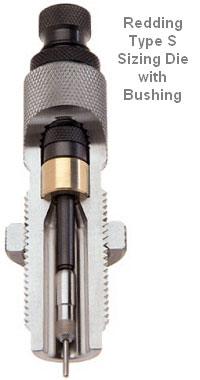1. At the Whidden custom die website they tell you that they get the most concentric ammunition from non-bushing full length dies.
2. German Salazar at the "Riflemans Journal" website did a bushing die test and when you reduce the neck diameter .004 or more it will induce neck runout. He goes on to state this is why it is recommended to reduce the neck diameter in 2 steps if reducing the neck diameter .004 or more.
Bottom line, there is enough clearance in the die body to allow the bushing to move side to side or even tilt. Meaning bushing dies work best with tight neck chambers and neck turned brass. And most standard SAAMI chambers allow the case neck to expand more than .004.
I get the least amount of case neck runout with Forster benchrest full length dies with their high mounted floating expander. And get the most case neck runout with a Forster bush bump die.
I do not blame the bushing dies, but the bushing floats and the stress of excessively reducing neck diameter lets the bushing move. Add this to a unturned case neck with excessive case neck thickness variations and you get even more neck runout.
Steps to Minimize Bullet Run-Out
Tech Line & Tips (FAQs)
Concentricity & Bushing Dies
From tests we have conducted, we have learned that selecting the correct bushing is the most important factor in producing sized case necks that have good concentricity with the case body. Our tests showed that case neck concentricity is directly proportional to bushing size. In other words, as you size case necks with progressively smaller bushings, the concentricity gets progressively worse. Our current recommendation, is to select a bushing that is .001 to .002" smaller than the loaded cartridge neck diameter. For example, if the neck diameter of your loaded cartridges is .248", start with a .247 or .246" bushing. We've had to change our initial recommendation, because some of cartridge cases manufactured today have neck walls near the minimum SAAMI thickness. When using brass which is at the thinner end of the SAAMI spec. we have found the bushing which is .001" smaller will provide the best result.
To create precision reloads, you must start with cases of good quality. They should all be from the same manufacturer and lot number. A good measure of case quality is how uniform the neck wall thickness is. Cases with uniform neck wall thickness, will be of uniform thickness all the way to the base. This is important for accuracy, as the cases will expand uniformly upon firing, and contract uniformly when sized. Neck turning helps, but it's only a partial cure, as you can't turn the case wall all the way to the base. The Redding Case Neck Gauge is the preferred instrument for checking neck wall thickness and uniformity. Also note that the concentricity of a fired case only indicates how concentric your firearm's chamber is. It provides you with little or no information on the quality of the cases you're using.
Other factors that can improve concentricity:
- Lube case necks, even with TiN coated bushings.
- Partial size case necks. Sizing 1/2 or 3/4 of the neck seems to be the most popular.
- Try flipping the bushing over. We like to install them with the letters down to start with.
- Trim cases mouths square so they will enter the bushing straight. Don't forget to chamfer the case mouth, inside and out. This is very important as it eases the entry of the case mouth into the bushing, and the bullet into the case mouth.
- Anneal case necks. Cases that have been fired many times work harden and this causes excessive spring-back of the case necks.
Advanced Reloading — Checking the Geometry of Neck Bushings
http://bulletin.accurateshooter.com...ading-checking-the-geometry-of-neck-bushings/


